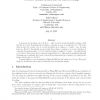Free Online Productivity Tools
i2Speak
i2Symbol
i2OCR
iTex2Img
iWeb2Print
iWeb2Shot
i2Type
iPdf2Split
iPdf2Merge
i2Bopomofo
i2Arabic
i2Style
i2Image
i2PDF
iLatex2Rtf
Sci2ools
APPROX
2005
Springer
2005
Springer
A Lower Bound on List Size for List Decoding
A q-ary error-correcting code C ⊆ {1, 2, . . . , q}n is said to be list decodable to radius ρ with list size L if every Hamming ball of radius ρ contains at most L codewords of C. We prove that in order for a q-ary code to be list-decodable up to radius (1 − 1/q)(1 − ε)n, we must have L = Ω(1/ε2 ). Specifically, we prove that there exists a constant cq > 0 and a function fq such that for small enough ε > 0, if C is list-decodable to radius (1 − 1/q)(1 − ε)n with list size cq/ε2 , then C has at most fq(ε) codewords, independent of n. This result is asymptotically tight (treating q as a constant), since such codes with an exponential (in n) number of codewords are known for list size L = O(1/ε2 ). A result similar to ours is implicit in Blinovsky [Bli] for the binary (q = 2) case. Our proof works for all alphabet sizes, and is technically and conceptually simpler.
Related Content
| Added | 26 Jun 2010 |
| Updated | 26 Jun 2010 |
| Type | Conference |
| Year | 2005 |
| Where | APPROX |
| Authors | Venkatesan Guruswami, Salil P. Vadhan |
Comments (0)

